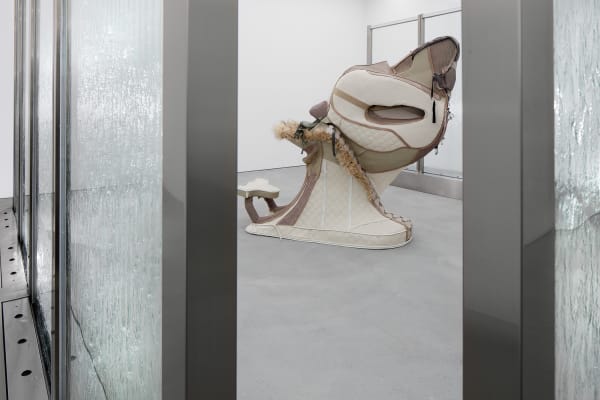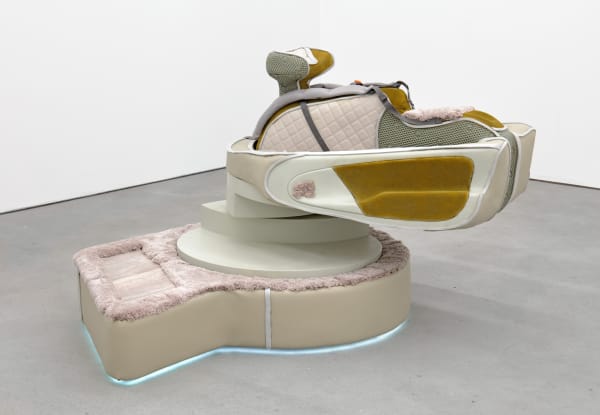SANTE PAR AQUA: ANNA UDDENBERG
Hijacking tropes of femininity prevalent in consumer culture, Anna Uddenberg’s sculptures exaggerate expectations of fitness, flexibility and sexuality to the degree that the absurdity of collective fantasies and the unfeasible demands they place on the body become apparent. Uddenberg’s subjects, contorted into improbable poses, seem to bend under pressure to conform to hyper-gendered, heavily reinforced representations of female identity.
The artist’s new non-figurative work signals a shift in interest towards architectural space that also presents unrealistic ideals. Examples that speak with covert insincerity of “luxury,” “safety,” “wellbeing,” or “comfort” abound in the first-class cabins of airliners, on super yachts, in well-appointed automobile interiors and in transit spas with extravagantly bolstered massage chairs. As the artist has done with the body in her figurative work, here quasi-functional objects also distort and accelerate the formal and material qualities they are based on to rational yet surreal conclusions.
For her solo presentation at Kraupa-Tuskany Zeidler, three sculptures occupy the main space of the gallery, deployed in a small flotilla. Like strange ships they guard the back room, a harbor within which a sphinx-like flagship is at anchor. There, a veil of water walls shrouds the work in an illicit privacy, producing counterfeit serenity through endless sheets of synthetic rain. Spa, the short form of the exhibition title, Sante Par Aqua, helps name the gallery’s transformation, while the title’s literal translation, Health Through Water, is mockingly repudiated through the humorous skepticism in Uddenberg’s works.
Through Uddenberg’s lens, the alien future of HR Giger is already in our midst, not as a dystopian vision—dark, industrial and wet—but as a heterotopia of luxury, safety and wellbeing. For Michel Foucault the heterotopia is a space for the body in crisis “outside of all places […] absolutely other with respect to the places they reflect.” Foucault continues that, “the ship is the heterotopia par excellence,” floating, “from port to port, tack by tack, from brothel to brothel,” as not only a, “great instrument of economic development,” but also “simultaneously the greatest reserve of the imagination.”
Uddenberg’s often nautically inflected sculptures also operate as screenplays for potential performers to explore what these environments expect from us, investigating the possibility that we may live in a neo-Victorian era where what appears on the surface to be banal and prudish is in fact sexually charged. In these works, both the forms and meanings of familiar elements are reconfigured into new furniture-like sculptures; their cryptic functions assert unexpected scripts for the bodies that might occupy them. Furniture – so often the site of the body’s first encounter with capitalist commercial agendas – here becomes a proxy for architecture.
Anna Uddenberg’s methods allow her to infiltrate and rewrite the code of commercial products and environments, putting their concepts, shapes, aesthetics, and materials into new dialogues with one another. This process not only introduces complexity into the ways in which we interact with and interpret these sculptures, but also draws attention to how their ubiquitous source material affects our subject formation in daily life, while opening up rigid systems to new readings and suggesting new positions (both literal and metaphorical).
-David Tasman













